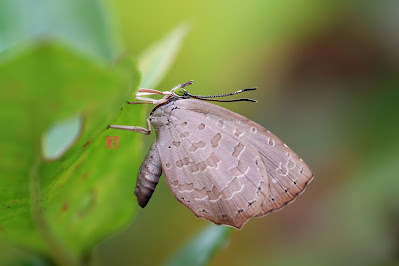The Bigg's Brownwing (Miletus biggsii biggsii)
A mating pair of Bigg's Brownwings amongst ants and coccids
The month of September usually brings on the Southwest monsoon squalls - strong winds blowing from the southwest of Singapore. These winds are also often called the "Sumatras". A Sumatra squall has characteristics that are specific to this region - it is a line of thunderstorms that develops over Indonesia's Sumatra island or the Strait of Malacca, then moves eastwards to affect Singapore and Peninsula Malaysia. On 17 September, such a squall hit Singapore island with enough severity to topple large trees and break branches. Over 300 trees were affected in Singapore, caused by strong winds that exceeded 80km/h.
Over in West Malaysia, which shares similar weather conditions of the Southwesterly monsoon winds, some fatalities were reported. In Penang, two unfortunate Chinese tourists were tragically killed when the winds blew down a tree that crushed the car that they were seated in. Elsewhere, in Pahang, a tree crushed an elderly man and injured his grand daughter at a site where they were camping. Another signal of climate change around the world where weather conditions exhibit more extreme outcomes?
September is also known for the celebration of the Mid-Autumn Festival that falls on the 15th day of the eighth lunar month. The full moon is considered a symbol of reunion, and is shining its brightest during this time. It is a month of delicious mooncakes and lantern parties where families delight in carrying lanterns at night, from traditional paper ones with wax candles to modern, battery-operated versions.
Our Butterfly of the Month for September 2024 is a representative of the sub-family Miletinae, often referred to as the "Harvesters". Our feature butterfly is the Bigg's Brownwing (Miletus biggsii biggsii). The common name of this species was Bigg's Brownie according to past literature, but has recently been changed to Brownwing to avoid the racially-sensitive word Brownie, sometimes misconstrued as a derogatory reference to dark-skinned people of certain races.
The Bigg's Brownwing usually flies in the shaded understorey of forested areas and patches of greenery around Singapore. They can be found in the nature reserves as well as urban parks and gardens. In particular the adult butterflies are often seen where their primary food source - several species of aphids and coccids are found. These insects are often "farmed" by ants.
The butterfly have a weak erratic flight and often remain in flight for long periods of time without taking a rest. Occasionally, they are spotted feeding on the sugary excretions of the aphids and coccids in the company of the ant farmers. Despite the ferocious ants guarding their source of food, the Bigg's Brownwing can alight on a group of ants and yet remain "invisible" to the ants such that the ants leave the butterfly unharmed.
A fluttering Bigg's Brownwing showing a glimpse of its upperside
The Bigg's Brownwing is light brown above with an oblique white band across the forewing - wider in the female than the male. Very often, this white band is reduced and obscure, and in some individuals, absent altogether. The underside of the butterfly is light-greyish brown with dark markings that gives the flat wings a 3-dimensional effect. There is a series of black submarginal spots on both wings and where the marginal edges of the wings take on a deeper orange shading.
Many photos of this species depict the butterfly in a sea of ants. Whereas other species of butterflies daring enough to do this would be torn to pieces by the ants and eaten, the Bigg's Brownwing somehow always remains unmolested and where the ants do not percieve it as a threat nor as food! The butterfly lays its eggs amongst the aphids or coccids and the caterpillars that hatch eat these insects as its source of food, making the species in the sub-family Miletinae "carnivorous".
Text by Khew SK : Photos by David Chan, Ash Foo, Khew SK, Michael Khor, Koh CH, Loke PF, Bene Tay and Mark Wong












